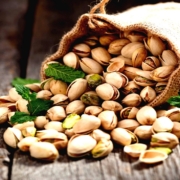Understanding Its Risks and Control Measures
Aflatoxin is a potent toxin produced by certain types of fungi, specifically the Aspergillus species. This naturally occurring compound is of significant concern due to its harmful effects on human and animal health. Aflatoxin contamination can occur in agricultural products, particularly in tropical and subtropical regions, where conditions like high humidity and warm temperatures are favorable for fungal growth.
In this article, we will explore the sources of aflatoxin, its risks, the crops most commonly affected, and methods to control and prevent contamination.
What is Aflatoxin?
Aflatoxins are a group of mycotoxins, which are toxic substances produced by fungi. There are several types of aflatoxins, with the most common being:
- Aflatoxin B1: The most toxic and commonly occurring aflatoxin, often found in contaminated food and feed.
- Aflatoxin B2
- Aflatoxin G1
- Aflatoxin G2
These toxins are primarily produced by the fungi Aspergillus flavus and Aspergillus parasiticus, which can infest crops both in the field and during storage. Aflatoxins can contaminate a wide range of food products, but they are most commonly associated with cereal crops, nuts, and legumes.
Sources and Contamination of Aflatoxin
Aflatoxin contamination occurs when the crops are infected by Aspergillus fungi, which release aflatoxins as they grow. These fungi thrive in warm, humid environments and can infect crops at any stage—from the growing season through to post-harvest storage. The following factors can increase the likelihood of aflatoxin contamination:
- Drought or Water Stress: Stress on plants due to drought conditions or water shortages increases the risk of fungal infection.
- Poor Storage Conditions: Improper storage, especially in warm and humid environments, provides an ideal setting for the growth of Aspergillus fungi.
- Insect Damage: Insects that damage crops can create entry points for fungi, further increasing the risk of contamination.
- Fungal Growth in the Field: If conditions are favorable for fungal growth during the growing season, crops like corn, peanuts, cottonseed, and tree nuts may become contaminated.
Crops Most Susceptible to Aflatoxin Contamination
Several agricultural products are particularly vulnerable to aflatoxin contamination:
- Corn (Maize): Aflatoxin contamination in corn is a major concern, especially in regions with hot and dry growing conditions. Aflatoxin B1 is frequently detected in maize, particularly after drought stress.
- Peanuts (Groundnuts): Peanuts are highly susceptible to fungal infection and aflatoxin production, often both in the field and during storage. Aflatoxin B1 is the most commonly found aflatoxin in peanuts.
- Cottonseed: Cotton crops, like corn and peanuts, are often contaminated with aflatoxins, especially when storage conditions are inadequate.
- Tree Nuts: Almonds, pistachios, and other tree nuts are prone to contamination, particularly when stored improperly after harvest.
- Dried Fruits and Spices: Dried fruits, such as figs, and certain spices, including red chili powder, have been reported to be contaminated with aflatoxins.
While aflatoxins are most often associated with these crops, other foodstuffs can also be affected, including grains, seeds, and animal feed.
Health Risks of Aflatoxin
The health risks posed by aflatoxins are significant, especially when consumed in large quantities over extended periods. Aflatoxins are highly toxic and carcinogenic, and their consumption can lead to a range of health problems:
- Acute Toxicity: Ingesting large amounts of aflatoxin in a short period can lead to acute aflatoxicosis, a condition that causes liver damage, jaundice, abdominal pain, vomiting, and even death in extreme cases.
- Chronic Exposure: Long-term, low-level exposure to aflatoxins is linked to a variety of chronic health conditions, with the most concerning being liver cancer. Aflatoxin B1, in particular, is classified as a Group 1 carcinogen by the International Agency for Research on Cancer (IARC).
- Liver Damage: Chronic aflatoxin exposure can cause liver cirrhosis and other liver-related diseases, as the toxin is metabolized by the liver. It can also interact with other substances, amplifying the risk of liver damage.
- Immunosuppression: Aflatoxins can suppress the immune system, making individuals more susceptible to infections and diseases.
- Growth Impairment in Children: Children are particularly vulnerable to aflatoxin exposure, which can stunt growth and impair cognitive development.
Global Impact of Aflatoxin Contamination
Aflatoxin contamination is a global concern, particularly in regions with hot, humid climates. The presence of aflatoxins in food can lead to significant economic losses for farmers and the food industry. In many developing countries, aflatoxin contamination is widespread, posing public health risks, especially where food safety regulations and monitoring systems are insufficient.
The World Health Organization (WHO) has estimated that aflatoxins are responsible for around 25% of the global cancer burden, with many of these cases occurring in developing nations. In addition to cancer, the public health impact of aflatoxins extends to other diseases, particularly in areas where aflatoxin-contaminated foods are a staple part of the diet.
Regulations and Control Measures
To mitigate the risks posed by aflatoxin contamination, various organizations, including the Food and Agriculture Organization (FAO), World Health Organization (WHO), and the European Union, have set maximum permissible levels of aflatoxins in food and feed. Regulatory agencies in many countries also routinely monitor aflatoxin levels in food products to ensure public safety.
Several strategies are employed to reduce aflatoxin contamination:
- Pre-harvest Control:
- Use of resistant crop varieties and genetic engineering to develop crops that are less susceptible to fungal infection.
- Proper agricultural practices, including proper irrigation and pest management, can reduce stress on plants and prevent fungal growth.
- Post-harvest Control:
- Proper drying and storage conditions are essential to prevent fungal growth. Crops should be dried to safe moisture levels and stored in cool, dry conditions.
- Regular inspection and monitoring of stored crops can help detect contamination early and minimize the spread of aflatoxins.
- Chemical Treatments:
- In some cases, fungicides may be used to control fungal growth, though their use is often limited by safety and environmental concerns.
- Certain natural products and biological control agents, such as beneficial fungi and bacteria, are also being explored as ways to reduce aflatoxin contamination in crops.
- Food Processing:
- In some cases, processing techniques like roasting, milling, or the removal of damaged grains can reduce the levels of aflatoxins in food products.
- However, aflatoxins are heat-resistant and cannot always be entirely eliminated through cooking or processing.
Conclusion
Aflatoxin contamination represents a serious public health risk, particularly in regions with inadequate food safety systems. While efforts are being made to control and prevent aflatoxin contamination, including improved agricultural practices, stricter regulations, and better monitoring, the problem persists. Raising awareness about the risks of aflatoxin exposure and ensuring better food safety measures can help reduce the impact of this dangerous toxin on human health. Consumers, especially in areas where aflatoxin contamination is a concern, should be mindful of food storage practices and sources of their food to help minimize the risks associated with aflatoxins.




Leave a Reply
Want to join the discussion?Feel free to contribute!